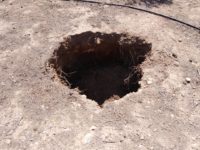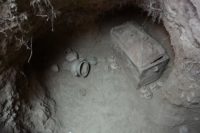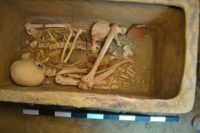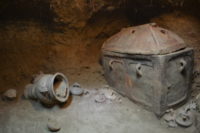 When an olive farmer in the village of Kentri near Ierapetra, southeast Crete, parked his truck in the shade of one his olive trees, the ground, oversaturated by a leaky irrigation pipe, retreated under its tires. Don’t worry. No harm came to the truck. A four-foot pit opened up underneath it is all, and when the farmer peered inside, he realized he and his truck had just made an archaeological discovery.
When an olive farmer in the village of Kentri near Ierapetra, southeast Crete, parked his truck in the shade of one his olive trees, the ground, oversaturated by a leaky irrigation pipe, retreated under its tires. Don’t worry. No harm came to the truck. A four-foot pit opened up underneath it is all, and when the farmer peered inside, he realized he and his truck had just made an archaeological discovery.
 He alerted the Lassithi Ephorate of Antiquities, the local heritage ministry, and they dispatched a team to do an emergency archaeological excavation of the pit. More than eight feet under the surface, archaeologists found an ancient chamber tomb entirely intact and undamaged by looters or faulty irrigation. It had been dug out of the soft limestone. Access to the chamber was provided by a vertical tunnel that was then sealed with clay masonry.
He alerted the Lassithi Ephorate of Antiquities, the local heritage ministry, and they dispatched a team to do an emergency archaeological excavation of the pit. More than eight feet under the surface, archaeologists found an ancient chamber tomb entirely intact and undamaged by looters or faulty irrigation. It had been dug out of the soft limestone. Access to the chamber was provided by a vertical tunnel that was then sealed with clay masonry.
 The tomb is 13 feet long with a vaulted ceiling and is divided into three carved niches each with its own funerary arrangement. In the southernmost area was a large covered larnax, a chest used as a coffin in the Minoan and Greek Bronze Age. When archaeologists lifted the cover, the saw the articulated skeleton of an adult.
The tomb is 13 feet long with a vaulted ceiling and is divided into three carved niches each with its own funerary arrangement. In the southernmost area was a large covered larnax, a chest used as a coffin in the Minoan and Greek Bronze Age. When archaeologists lifted the cover, the saw the articulated skeleton of an adult.
 In the second niche just in front of that larnax were a group of pottery vessels: 14 small ritual amphorae and a large krater (used to mix water and wine). The third niche in the northernmost area of the tomb held another larnaca. This one was broken and had no cover. Skeletal remains were found inside of it, but the skeleton was eroded after having been exposed. In front of the coffin were another 8 vases, six of them ritual amphorae.
In the second niche just in front of that larnax were a group of pottery vessels: 14 small ritual amphorae and a large krater (used to mix water and wine). The third niche in the northernmost area of the tomb held another larnaca. This one was broken and had no cover. Skeletal remains were found inside of it, but the skeleton was eroded after having been exposed. In front of the coffin were another 8 vases, six of them ritual amphorae.
All of the ceramics are intact and in good condition. Enough so that experts were able to date to the tomb based on the ceramic typology. It dates from 1400 to 1200 BC, the Late Minoan IIIA-B period.
“The positive thing is that they were not emptied by thieves and this will help archaeologists get as much information as possible. This is a great day for Ierapetra. When you see that in a 4 meter hole there are such important antiquities you feel awe,” Argyris Pantazis, deputy mayor of Local Communities, Agrarian and Tourism of Ierapetra, told cretapost.
I assume that the lid of the larnax was originally fitted on square, and that it has shifted with earthquake shaking. Which is an intriguing thought, to be in such a cemetery, at night during an earthquake, listening to one’s ancestors’ burial chests clanking…
There are olive trees on the island that are from the Late Minoan IIIA-B period too, and they witnessed a few quakes. However, when I was there, checking the olive trees a few kilometers to the West of Ierapetra, there were no clanking sounds (but no quakes either).
Tombs should be there galore, but instead there was a tiny single almond tree with exactly one single almond on it. I took a stone, opened it and it was one of the best that I ever had – In case I had poisoned myself, of course, it would literally have been in the middle of nowhere :skull:
Fascinating!
His (or hers?) bones are definitely brittle, but is that yet another brittle fracture, there on his ‘os frontale’ or a clear cut to the head?
What about the ‘occipital bone’? That thickening seems to be normal, but could there be more to it? Violent death or not?
How old? In case of another ‘Larnax’ case, are we possibly having husband and wife? In absence of weapons, was this an olive farmer? :confused:
Imagine just going about your day and discovering a huge archeological find! So cool!